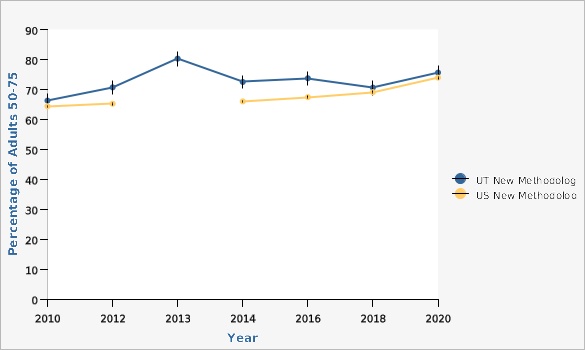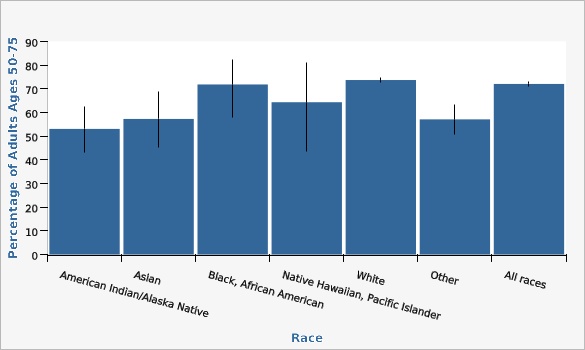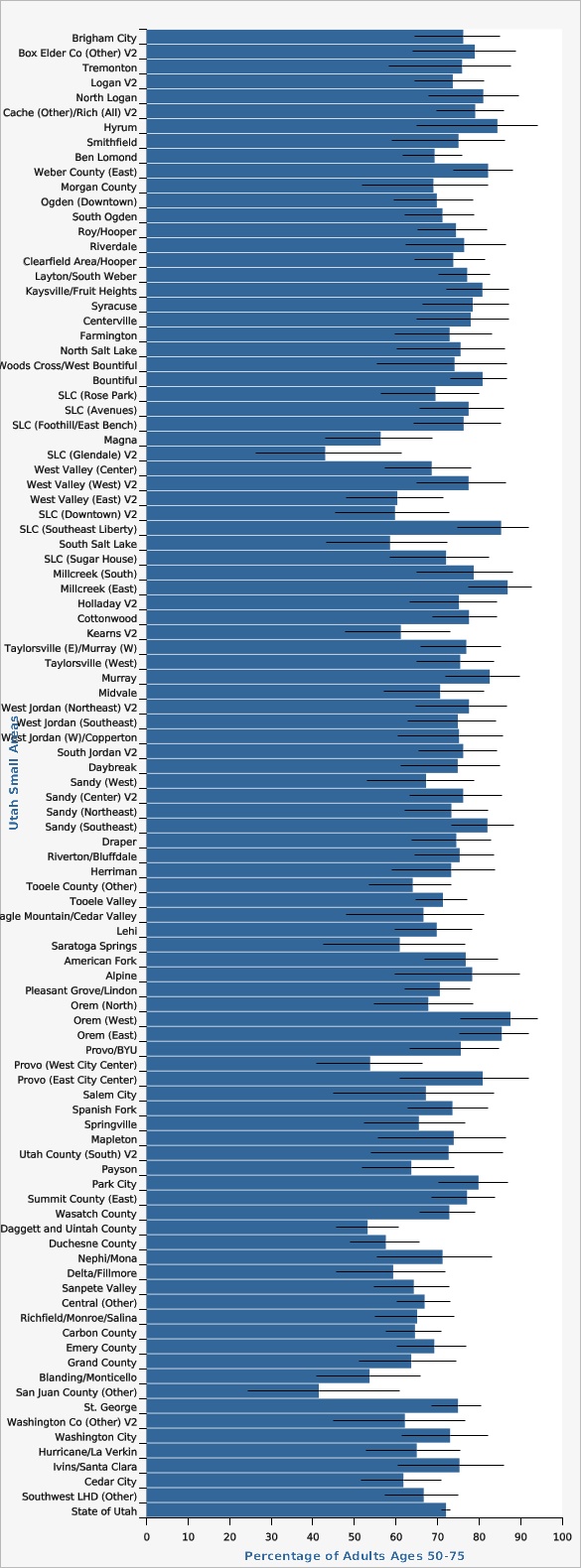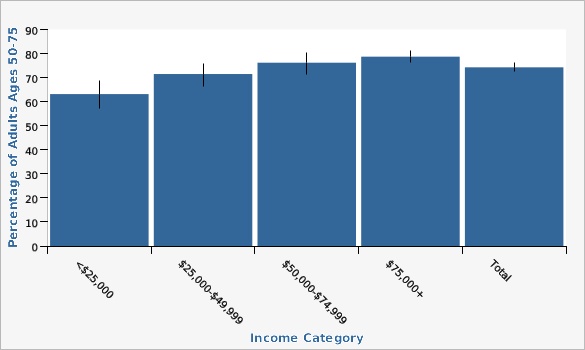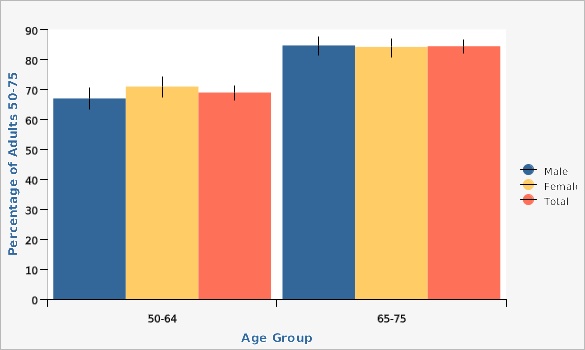Complete Health Indicator Report of Colorectal Cancer Screening
Definition
The proportion of respondents ages 50-75 who reported having recommended colorectal cancer screening (sigmoidoscopy or colonoscopy in the past 10 years or having an FOBT [fecal occult blood test] in the last year).Numerator
The number of respondents ages 50-75 reported having recommended colorectal cancer screening (sigmoidoscopy or colonoscopy in the past 10 years or having an FOBT [fecal occult blood test] in the last year).Denominator
The total number of survey respondents aged 50-75 excluding those who answered "don't know" or "refused" to the numerator question.Data Interpretation Issues
To reduce bias and more accurately represent population data, the BRFSS has changed survey methodology. In 2010, it began conducting surveys by cellular phone in addition to landline phones. It also adopted "iterative proportional fitting" (raking) as its weighting method. In 2016 age distribution changed from 8 age groups to 5 age groups. This change in methodology may affect interpretation of data trends.Why Is This Important?
Colorectal cancer is one of the leading causes of cancer-related deaths in the U.S. and Utah. Screening for this cancer is important as deaths can be substantially reduced when precancerous polyps are detected at early stages and removed. The chance of surviving colorectal cancer exceeds 90% when the cancer is diagnosed before it has extended beyond the intestinal wall ([http://www.cancer.org]). The U.S. Preventive Services Task Force recommends that routine screening for colorectal cancer begin at age 45 for adults at average risk. Persons at high risk may need to begin screening at a younger age. Routine screening can include either an annual fecal occult blood test (FOBT), a flexible sigmoidoscopy every five years, a colonoscopy every 10 years, or a double-contrast barium enema every 5 to 10 years.Other Objectives
CSTE Chronic Disease Indicators Similar to HP2020 Objective C-16: Increase the proportion of adults who receive a colorectal cancer screening based on the most recent guidelines.How Are We Doing?
Colorectal cancer screening rates in Utah have generally increased over the last decade, with a screening rate of 62.3% in 2010 increasing to a rate of 74.1% in 2020 among adults aged 50-74. Colorectal cancer screening rates across the state vary by geography and other sociodemographic factors. Among local health districts (LHDs) in 2020, San Juan LHD (42.7%), TriCounty LHD (50.1%), and Southeast Utah LHD (64.6%) had significantly lower colorectal cancer screening rates than the state average (74.3%). See additional data views for more specific differences between Utah Small Areas. In 2020, Hispanic adults aged 50-75 were significantly less likely (59.1%) than non-Hispanic adults (76.1%) to report having completed the recommended colorectal cancer screening. Those who racially identified as Asian (57.3%) or American Indian/Alaskan Native (53.1%) were also significantly less likely to report having completed the recommended colorectal cancer screening compared to all races (72.1%) for combined years 2016, 2018, and 2020. In 2020, those who reported having received less than a high school education were screened for colorectal cancer at significantly lower rates (53.4%) than others who had more education. Average colorectal cancer screening rates increased with each additional education level attained. Also in 2020, those who reported an annual household income of less than $25,000 were significantly less likely to report having completed a recommended colorectal cancer screening (63.2%) compared to those with higher incomes. Adults aged 65-75 were significantly more likely to report having received a recommended colorectal cancer screening (84.4%) than adults aged 50-64 (69.0%) based on 2020 BRFSS data. There was no significant difference in colorectal cancer screening rates between males and females.How Do We Compare With the U.S.?
Nationally, the percentage of adults aged 50-74 completing recommended colorectal cancer screening was 73.9% in 2020, compared to the Utah screening rate of 74.1%. Current data appears to parallel previously seen trends, with Utah screening rates being comparable to the U.S. average.What Is Being Done?
Screening for colorectal cancer has recently been identified by the Centers for Disease Control and Prevention (CDC) as a priority public health issue.Available Services
Coverage of colorectal cancer screening tests is required by the Affordable Care Act (ACA). However, the ACA doesn't apply to health plans that were in place before it was passed (so-called grandfathered plans). You can find out your insurance plan's grandfathered status by contacting your health insurance company or your employer's human resources department. If your plan started on or after September 23, 2010, it is required to cover colonoscopies and other colorectal cancer screening tests. If a plan started before September 23, 2010, it may still have coverage requirements from state laws, which vary, and other federal laws.Health Program Information
The mission of the Utah Cancer Coalition is to lower cancer incidence, morbidity, and mortality in Utah through collaborative efforts directed toward cancer prevention and control. As a result, they support community-based strategies around food security, healthy neighborhoods, access to healthcare, and financial toxicity in order to prevent cancer; detect cancer early; and improve the lives of cancer survivors, caregivers, and their families.Related Indicators
Relevant Population Characteristics
The U.S. Preventive Services Task Force recommends that adults age 45 to 75 be screened for colorectal cancer.Related Relevant Population Characteristics Indicators:
Health Care System Factors
Medicare will pay for an annual fecal occult blood test, a flexible sigmoidoscopy every four years, and a colonoscopy every ten years for persons with Medicare aged 50 or older who are at average risk for colorectal cancer. Medicare also covers surveillance of high risk patients (those with a personal history of colorectal cancer or adenomatous polyps or a history of colorectal cancer or adenomatous polyps in a first degree relative or those diagnosed with inflammatory bowel disease) with colonoscopy every two years.Related Health Care System Factors Indicators:
Risk Factors
Colorectal cancer risk increases with age, inflammatory bowel disease, a personal or family history of colorectal cancer or polyps, and certain hereditary syndromes. A diet high in fat and low in fiber, lack of regular physical activity, obesity, excessive alcohol consumption, and smoking are also thought to increase risk. A diet high in fruits and vegetables, hormone replacement therapy in post-menopausal women, and aspirin use may reduce colorectal cancer risk.Related Risk Factors Indicators:
Health Status Outcomes
When colorectal cancers are detected at an early, localized stage of disease, the 5-year survival rate is 90%. However, only 39% of colorectal cancers are discovered at that stage ([http://www.cancer.org]).Related Health Status Outcomes Indicators:
Graphical Data Views
Please note: In May 2021, the U.S. Preventive Services Task Force changed its colorectal cancer screening recommendation. The age at which adults at average risk of getting colorectal cancer were recommended to begin screening was lowered from 50 to 45. The data shown here do not include adults younger than age 50.
| BRFSS Utah vs. U.S. | Year | Percentage of Adults 50-75 | Lower Limit | Upper Limit | Note | |
|---|---|---|---|---|---|---|
Record Count: 13 | ||||||
| UT New Methodology | 2010 | 66.3% | 63.8% | 68.6% | *ages 50-74 | |
| UT New Methodology | 2012 | 70.7% | 68.4% | 72.9% | *ages 50-74 | |
| UT New Methodology | 2013 | 80.3% | 77.7% | 82.7% | *ages 50-74 | |
| UT New Methodology | 2014 | 72.5% | 70.2% | 74.6% | *ages 50-74 | |
| UT New Methodology | 2016 | 73.7% | 71.3% | 76.0% | *ages 50-74 | |
| UT New Methodology | 2018 | 70.6% | 68.0% | 73.1% | *ages 50-74 | |
| UT New Methodology | 2020 | 75.6% | 73.2% | 77.9% | *ages 50-74 | |
| US New Methodology | 2010 | 64.4% | 64.0% | 64.7% | *ages 50-74 | |
| US New Methodology | 2012 | 65.2% | 64.8% | 65.6% | *ages 50-74 | |
| US New Methodology | 2014 | 66.0% | 65.6% | 66.4% | *ages 50-74 | |
| US New Methodology | 2016 | 67.4% | 67.0% | 67.8% | *ages 50-74 | |
| US New Methodology | 2018 | 69.1% | 68.6% | 69.6% | *ages 50-74 | |
| US New Methodology | 2020 | 73.9% | 73.4% | 74.5% | *ages 50-74 | |
Data Notes
^ ^*National BRFSS data is published in 5 year age groupings and query by age group 50-75 is not possible, therefore ages 50-74 is used instead. Utah data is also presented for adults ages 50-74 for better comparison to national rates. Due to changes in survey methodology and changes in U.S. Preventive Services Task Force guidelines, only data after 2010 is presented.Data Sources
- Utah Department of Health and Human Services Behavioral Risk Factor Surveillance System (BRFSS) [https://ibis.health.utah.gov/ibisph-view/query/selection/brfss/BRFSSSelection.html]
- Behavioral Risk Factor Surveillance System Survey Data, US Department of Health and Human Services Centers for Disease Control and Prevention (CDC).
| Hispanic Ethnicity | Percentage of Adults Ages 50-75 | Lower Limit | Upper Limit | |||
|---|---|---|---|---|---|---|
Record Count: 3 | ||||||
| Hispanic/Latino | 59.1% | 50.2% | 67.4% | |||
| Non-Hispanic/Latino | 76.1% | 74.3% | 77.8% | |||
| All ethnicities | 74.3% | 72.4% | 76.1% | |||
Data Source
Utah Department of Health and Human Services Behavioral Risk Factor Surveillance System (BRFSS) [https://ibis.health.utah.gov/ibisph-view/query/selection/brfss/BRFSSSelection.html]| Race | Percentage of Adults Ages 50-75 | Lower Limit | Upper Limit | |||
|---|---|---|---|---|---|---|
Record Count: 7 | ||||||
| American Indian/Alaska Native | 53.1% | 43.3% | 62.6% | |||
| Asian | 57.3% | 45.0% | 68.7% | |||
| Black, African American | 71.8% | 58.1% | 82.5% | |||
| Native Hawaiian, Pacific Islander | 64.3% | 43.4% | 80.9% | |||
| White | 73.7% | 72.6% | 74.8% | |||
| Other | 57.1% | 50.7% | 63.2% | |||
| All races | 72.1% | 71.0% | 73.1% | |||
Data Source
Utah Department of Health and Human Services Behavioral Risk Factor Surveillance System (BRFSS) [https://ibis.health.utah.gov/ibisph-view/query/selection/brfss/BRFSSSelection.html]| Utah Small Areas | Percentage of Adults Ages 50-75 | Lower Limit | Upper Limit | Note | ||
|---|---|---|---|---|---|---|
Record Count: 100 | ||||||
| Brigham City | 76.2% | 64.4% | 85.0% | |||
| Box Elder Co (Other) V2 | 79.0% | 64.2% | 88.8% | |||
| Tremonton | 75.9% | 58.3% | 87.7% | * | ||
| Logan V2 | 73.7% | 64.6% | 81.2% | |||
| North Logan | 81.0% | 67.9% | 89.6% | |||
| Cache (Other)/Rich (All) V2 | 79.1% | 69.8% | 86.1% | |||
| Hyrum | 84.4% | 64.9% | 94.1% | * | ||
| Smithfield | 75.1% | 59.0% | 86.3% | |||
| Ben Lomond | 69.3% | 61.6% | 76.1% | |||
| Weber County (East) | 82.2% | 73.9% | 88.3% | |||
| Morgan County | 69.0% | 51.8% | 82.2% | |||
| Ogden (Downtown) | 69.9% | 59.4% | 78.6% | |||
| South Ogden | 71.2% | 62.1% | 78.9% | |||
| Roy/Hooper | 74.5% | 65.2% | 81.9% | |||
| Riverdale | 76.4% | 62.4% | 86.4% | |||
| Clearfield Area/Hooper | 73.8% | 64.4% | 81.4% | |||
| Layton/South Weber | 77.2% | 70.4% | 82.8% | |||
| Kaysville/Fruit Heights | 80.8% | 72.1% | 87.3% | |||
| Syracuse | 78.5% | 66.3% | 87.1% | |||
| Centerville | 78.0% | 65.0% | 87.2% | |||
| Farmington | 72.9% | 59.6% | 83.1% | |||
| North Salt Lake | 75.6% | 60.2% | 86.3% | |||
| Woods Cross/West Bountiful | 74.1% | 55.4% | 86.8% | * | ||
| Bountiful | 80.9% | 73.2% | 86.7% | |||
| SLC (Rose Park) | 69.5% | 56.4% | 80.1% | |||
| SLC (Avenues) | 77.5% | 65.7% | 86.1% | |||
| SLC (Foothill/East Bench) | 76.3% | 64.2% | 85.3% | |||
| Magna | 56.4% | 42.9% | 68.9% | |||
| SLC (Glendale) V2 | 43.0% | 26.3% | 61.5% | |||
| West Valley (Center) | 68.6% | 57.4% | 78.1% | |||
| West Valley (West) V2 | 77.5% | 64.9% | 86.5% | |||
| West Valley (East) V2 | 60.4% | 48.1% | 71.4% | |||
| SLC (Downtown) V2 | 59.8% | 45.3% | 72.8% | |||
| SLC (Southeast Liberty) | 85.3% | 74.8% | 91.9% | |||
| South Salt Lake | 58.6% | 43.3% | 72.4% | |||
| SLC (Sugar House) | 72.1% | 58.6% | 82.5% | |||
| Millcreek (South) | 78.7% | 64.9% | 88.1% | |||
| Millcreek (East) | 86.9% | 77.4% | 92.8% | |||
| Holladay V2 | 75.2% | 63.2% | 84.2% | |||
| Cottonwood | 77.6% | 68.9% | 84.4% | |||
| Kearns V2 | 61.2% | 47.8% | 73.1% | |||
| Taylorsville (E)/Murray (W) | 77.0% | 66.0% | 85.2% | |||
| Taylorsville (West) | 75.5% | 65.1% | 83.6% | |||
| Murray | 82.6% | 71.9% | 89.8% | |||
| Midvale | 70.7% | 57.2% | 81.3% | |||
| West Jordan (Northeast) V2 | 77.6% | 64.8% | 86.7% | |||
| West Jordan (Southeast) | 74.9% | 62.9% | 84.0% | |||
| West Jordan (W)/Copperton | 75.2% | 60.6% | 85.7% | |||
| South Jordan V2 | 76.2% | 65.6% | 84.4% | |||
| Daybreak | 74.9% | 61.2% | 85.0% | |||
| Sandy (West) | 67.3% | 53.1% | 78.8% | |||
| Sandy (Center) V2 | 76.2% | 63.4% | 85.6% | |||
| Sandy (Northeast) | 73.4% | 62.2% | 82.2% | |||
| Sandy (Southeast) | 82.0% | 73.4% | 88.3% | |||
| Draper | 74.6% | 63.7% | 83.0% | |||
| Riverton/Bluffdale | 75.4% | 64.6% | 83.7% | |||
| Herriman | 73.3% | 59.1% | 84.0% | |||
| Tooele County (Other) | 64.1% | 53.6% | 73.3% | |||
| Tooele Valley | 71.3% | 64.7% | 77.1% | |||
| Eagle Mountain/Cedar Valley | 66.6% | 48.1% | 81.2% | |||
| Lehi | 69.8% | 59.8% | 78.3% | |||
| Saratoga Springs | 60.9% | 42.6% | 76.6% | |||
| American Fork | 76.8% | 66.8% | 84.5% | |||
| Alpine | 78.4% | 59.7% | 89.9% | * | ||
| Pleasant Grove/Lindon | 70.6% | 62.2% | 77.8% | |||
| Orem (North) | 67.8% | 54.8% | 78.6% | |||
| Orem (West) | 87.6% | 75.4% | 94.2% | * | ||
| Orem (East) | 85.5% | 75.2% | 91.9% | |||
| Provo/BYU | 75.6% | 63.3% | 84.8% | |||
| Provo (West City Center) | 53.8% | 40.8% | 66.3% | |||
| Provo (East City Center) | 80.9% | 61.0% | 92.0% | * | ||
| Salem City | 67.2% | 45.0% | 83.7% | * | ||
| Spanish Fork | 73.6% | 62.9% | 82.1% | |||
| Springville | 65.5% | 52.2% | 76.8% | |||
| Mapleton | 73.9% | 55.7% | 86.5% | * | ||
| Utah County (South) V2 | 72.7% | 54.0% | 85.8% | * | ||
| Payson | 63.7% | 51.9% | 74.0% | |||
| Park City | 79.9% | 70.3% | 87.0% | |||
| Summit County (East) | 77.1% | 68.5% | 84.0% | |||
| Wasatch County | 72.9% | 65.6% | 79.1% | |||
| Daggett and Uintah County | 53.2% | 45.6% | 60.7% | |||
| Duchesne County | 57.6% | 49.1% | 65.7% | |||
| Nephi/Mona | 71.2% | 55.4% | 83.2% | |||
| Delta/Fillmore | 59.4% | 45.5% | 71.8% | |||
| Sanpete Valley | 64.3% | 54.8% | 72.8% | |||
| Central (Other) | 66.9% | 60.2% | 73.0% | |||
| Richfield/Monroe/Salina | 65.1% | 55.0% | 74.0% | |||
| Carbon County | 64.6% | 57.7% | 70.9% | |||
| Emery County | 69.2% | 60.2% | 77.0% | |||
| Grand County | 63.7% | 51.2% | 74.5% | |||
| Blanding/Monticello | 53.7% | 40.9% | 66.0% | |||
| San Juan County (Other) | 41.5% | 24.4% | 60.8% | |||
| St. George | 75.0% | 68.6% | 80.4% | |||
| Washington Co (Other) V2 | 62.2% | 45.0% | 76.8% | |||
| Washington City | 73.0% | 61.4% | 82.2% | |||
| Hurricane/La Verkin | 65.0% | 52.8% | 75.6% | |||
| Ivins/Santa Clara | 75.3% | 60.4% | 85.9% | |||
| Cedar City | 61.8% | 51.6% | 71.1% | |||
| Southwest LHD (Other) | 66.7% | 57.3% | 75.0% | |||
| State of Utah | 72.1% | 71.0% | 73.1% | |||
Data Notes
A description of the Utah Small Areas may be found on IBIS at the following URL: [http://ibis.health.utah.gov/pdf/resource/UtahSmallAreaInfo.pdf]. *Use caution in interpreting; the estimate has a coefficient of variation >30% and is therefore deemed unreliable by the Utah Department of Health and Human Services.Data Source
Utah Department of Health and Human Services Behavioral Risk Factor Surveillance System (BRFSS) [https://ibis.health.utah.gov/ibisph-view/query/selection/brfss/BRFSSSelection.html]| Local Health District | Percentage of Adults Ages 50-75 | Lower Limit | Upper Limit | |||
|---|---|---|---|---|---|---|
Record Count: 14 | ||||||
| Bear River | 77.1% | 69.8% | 83.2% | |||
| Central | 67.3% | 59.0% | 74.6% | |||
| Davis County | 78.2% | 72.3% | 83.2% | |||
| Salt Lake County | 76.3% | 72.9% | 79.3% | |||
| San Juan | 42.7% | 25.2% | 62.3% | |||
| Southeast | 64.6% | 55.5% | 72.7% | |||
| Southwest | 70.0% | 63.0% | 76.2% | |||
| Summit | 78.4% | 66.3% | 87.0% | |||
| Tooele | 73.9% | 63.1% | 82.4% | |||
| TriCounty | 50.1% | 38.5% | 61.7% | |||
| Utah County | 74.8% | 70.0% | 79.1% | |||
| Wasatch | 75.9% | 64.5% | 84.5% | |||
| Weber-Morgan | 73.1% | 66.7% | 78.6% | |||
| State of Utah | 74.3% | 72.4% | 76.1% | |||
Data Source
Utah Department of Health and Human Services Behavioral Risk Factor Surveillance System (BRFSS) [https://ibis.health.utah.gov/ibisph-view/query/selection/brfss/BRFSSSelection.html]| Education Level | Percentage of Adults Ages 50-75 | Lower Limit | Upper Limit | |||
|---|---|---|---|---|---|---|
Record Count: 5 | ||||||
| Less than high school | 53.4% | 43.2% | 63.4% | |||
| H.S. grad or G.E.D. | 72.0% | 67.9% | 75.7% | |||
| Some post high school | 74.8% | 71.7% | 77.6% | |||
| College graduate | 80.3% | 77.8% | 82.6% | |||
| Total | 74.3% | 72.4% | 76.1% | |||
Data Source
Utah Department of Health and Human Services Behavioral Risk Factor Surveillance System (BRFSS) [https://ibis.health.utah.gov/ibisph-view/query/selection/brfss/BRFSSSelection.html]| Income Category | Percentage of Adults Ages 50-75 | Lower Limit | Upper Limit | |||
|---|---|---|---|---|---|---|
Record Count: 5 | ||||||
| <$25,000 | 63.2% | 57.1% | 68.8% | |||
| $25,000-$49,999 | 71.5% | 66.5% | 76.0% | |||
| $50,000-$74,999 | 76.2% | 71.4% | 80.4% | |||
| $75,000+ | 78.7% | 76.1% | 81.1% | |||
| Total | 74.3% | 72.4% | 76.1% | |||
Data Source
Utah Department of Health and Human Services Behavioral Risk Factor Surveillance System (BRFSS) [https://ibis.health.utah.gov/ibisph-view/query/selection/brfss/BRFSSSelection.html]| Males vs. Females | Age Group | Percentage of Adults 50-75 | Lower Limit | Upper Limit | ||
|---|---|---|---|---|---|---|
Record Count: 6 | ||||||
| Male | 50-64 | 67.0% | 63.2% | 70.5% | ||
| Male | 65-75 | 84.7% | 81.3% | 87.5% | ||
| Female | 50-64 | 71.0% | 67.4% | 74.3% | ||
| Female | 65-75 | 84.2% | 80.8% | 87.1% | ||
| Total | 50-64 | 69.0% | 66.4% | 71.4% | ||
| Total | 65-75 | 84.4% | 82.1% | 86.5% | ||
Data Source
Utah Department of Health and Human Services Behavioral Risk Factor Surveillance System (BRFSS) [https://ibis.health.utah.gov/ibisph-view/query/selection/brfss/BRFSSSelection.html]References and Community Resources
Utah Breast & Cervical Cancer Screening Program: [https://cancer.utah.gov/][[br]] Utah Cancer Coalition: [https://utahcancercoalition.org/][[br]] American Cancer Society: [http://www.cancer.org][[br]] National Cancer Institute: [http://www.cancer.gov][[br]] Huntsman Cancer Institute: [https://healthcare.utah.edu/huntsmancancerinstitute/screening-prevention][[br]] Centers for Disease Control and Prevention: [http://www.cdc.gov][[br]] American Society of Clinical Oncology: [http://www.asco.org][[br]]More Resources and Links
Evidence-based community health improvement ideas and interventions may be found at the following sites:Additional indicator data by state and county may be found on these Websites:
- CDC Prevention Status Reports for all 50 states
- County Health Rankings
- Kaiser Family Foundation's StateHealthFacts.org
- CDC WONDER DATA2010, the Healthy People 2010 Database.
Medical literature can be queried at the PubMed website.
Page Content Updated On 03/26/2024,
Published on 04/22/2024




